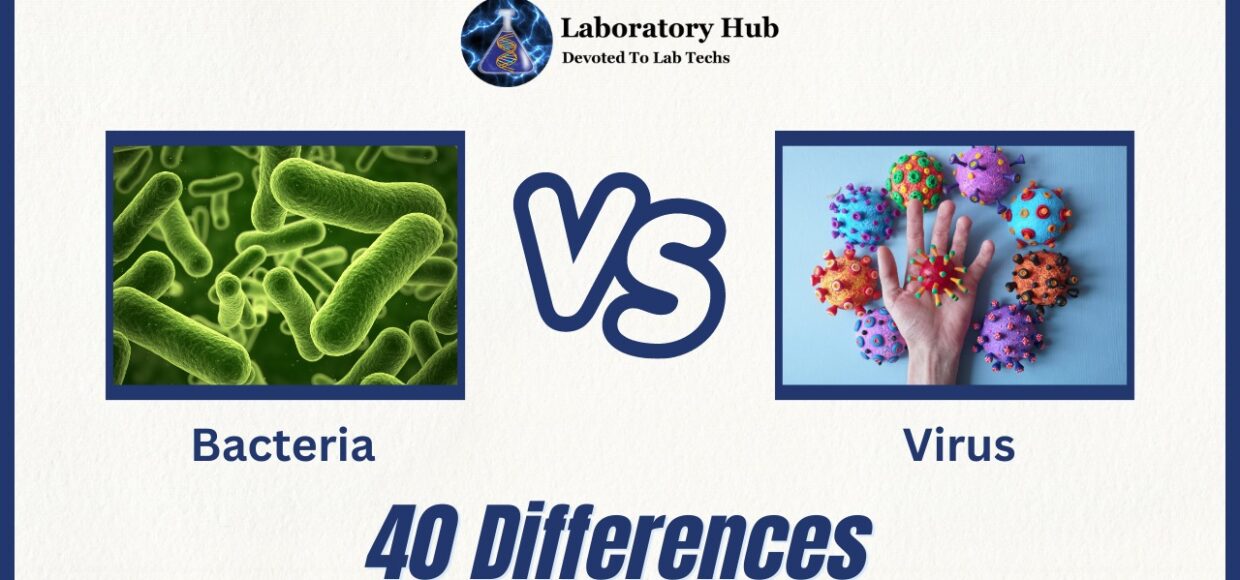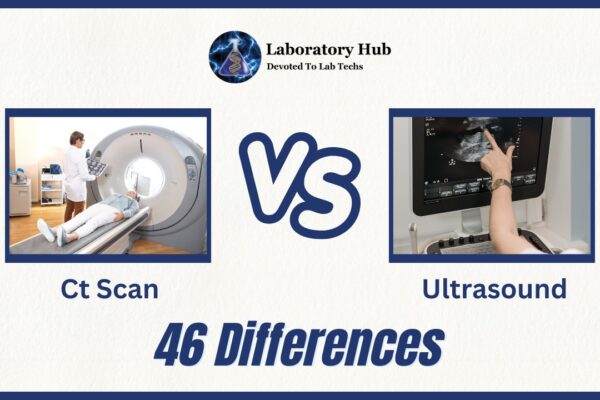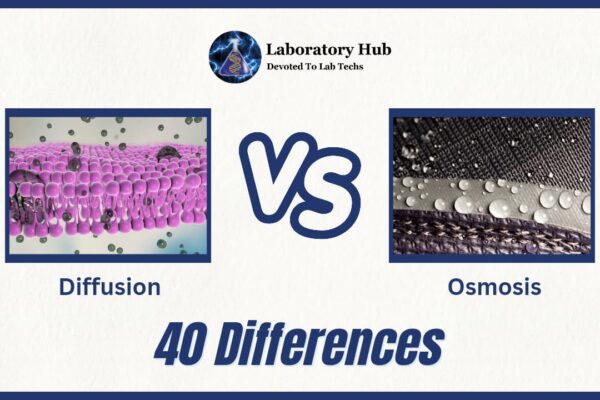Bacteria vs Virus: 40 Differences
Bacteria and viruses are the most fascinating microorganisms. Microscopic creatures affect our health, environment, and history. To understand bacteria and viruses’ behavior, modalities of infection, and effective prevention and therapy, one must understand their basic distinctions.
Prokaryotic bacteria are found in practically every ecosystem on Earth. They are present in soil, water, air, and human bodies as rods, spheres, and spirals. Bacteria support ecosystems and human health, yet some cause illnesses. Certain bacteria promote digestion, create vitamins, and fight pathogens.
However, viruses are acellular, living-nonliving creatures. They lack bacteria’s replication and metabolic mechanism. Viruses need host cells to live. DNA or RNA is encased in a protein sheath in these small infectious agents. Despite their simplicity, viruses may penetrate live cells and hijack their biological machinery to proliferate, causing many illnesses in people, animals, and plants.
Bacteria and viruses both cause illnesses, however their infection and action methods differ. Bacteria may replicate independently, create toxins, and harm host tissues, causing diseases. Viruses must multiply within host cells. They infect host cells, inject their genetic material, and push them to make more viral particles, disrupting cellular activities and causing illness symptoms.
Viral and bacterial treatment susceptibility differs. Antibiotics are commonly used to treat bacterial infections. These medications cannot target viruses because they lack metabolic machinery. Instead, antivirals and vaccinations hinder viral replication or stimulate the immune system to fight the virus.
Bacteria and viruses are amazing microbes that affect human health and the environment. Bacteria are benign and destructive, while viruses are intracellular parasites that need host cells to replicate. Understanding the underlying distinctions between bacteria and viruses is essential for establishing effective tactics to battle their illnesses, enhance public health, and secure a safer future for all. By understanding these tiny opponents, we may better tackle them and unleash new microbiological discoveries.
Also read: Archaea vs Bacteria- 20 Differences
S.No. | Category | Bacteria | Viruses |
1 | Size | Bacteria are larger, typically ranging from 0.2 to 10 micrometers in size. | Viruses are much smaller, typically ranging from 20 to 300 nanometers in size. |
2 | Cellular Structure | Bacteria are cellular organisms with a complex cellular structure, including a cell membrane, cytoplasm, and genetic material (DNA or RNA). | Viruses are acellular entities that lack cellular structures and are composed of genetic material (DNA or RNA) surrounded by a protein coat called a capsid. |
3 | Living or Non-living | Bacteria are considered living organisms as they can carry out essential life processes, including reproduction and metabolism. | Viruses are considered non-living as they require a host cell to replicate and cannot carry out independent metabolism. |
4 | Reproduction | Bacteria can reproduce independently through binary fission, where one bacterium divides into two identical daughter cells. | Viruses require a host cell to replicate and reproduce by hijacking the host cell’s machinery to produce new viral particles. |
5 | Genetic Material | Bacteria have DNA as their genetic material, and some bacteria may also have plasmids—small, circular DNA molecules. | Viruses can have either DNA or RNA as their genetic material, which can be single-stranded or double-stranded. |
6 | Metabolism | Bacteria have diverse metabolic capabilities and can carry out various metabolic processes, such as respiration, fermentation, and photosynthesis. | Viruses do not have their own metabolism and rely on host cells to provide the necessary cellular machinery and resources for their replication. |
7 | Cellular Organization | Bacteria are prokaryotic cells lacking a nucleus and other membrane-bound organelles. | Viruses are not cells and do not have any cellular organization. |
8 | Examples | Examples of bacteria include Escherichia coli (E. coli), Streptococcus pneumoniae, and Bacillus subtilis. | Examples of viruses include Influenza virus, Human Immunodeficiency Virus (HIV), and Herpes simplex virus. |
9 | Antibiotic Sensitivity | Bacteria can be treated with antibiotics that target specific cellular structures or processes, such as cell wall synthesis or protein synthesis. | Viruses are not affected by antibiotics as they do not have their own cellular structures or metabolic processes targeted by antibiotics. |
10 | Host Range | Bacteria can infect a wide range of hosts, including animals, plants, and even other bacteria. | Viruses typically have a narrow host range and can only infect specific host species or cell types. |
11 | Cell Wall | Bacteria have diverse cell wall compositions, including peptidoglycan in the cell wall of Gram-positive bacteria and a combination of lipopolysaccharide and peptidoglycan in the cell wall of Gram-negative bacteria. | Viruses do not have cell walls as they are acellular entities. |
12 | Surface Structures | Bacteria may have various surface structures like pili, flagella, or capsules, which aid in attachment, movement, or protection. | Viruses do not have surface structures like pili or flagella. Some viruses may have a viral envelope derived from the host cell’s membrane. |
13 | Immune Response | Bacterial infections can elicit an immune response from the host, including the production of antibodies and activation of immune cells. | Viral infections also trigger an immune response, but viruses can evade or suppress the immune response, leading to persistent infections. |
14 | Evolution | Bacteria can evolve through mutations, genetic recombination, and horizontal gene transfer. | Viruses can also undergo genetic mutations and recombination, leading to the emergence of new viral strains or variants. |
15 | Multicellularity | Bacteria can exist as single cells or form multicellular structures like biofilms, where bacteria aggregate and cooperate in a community. | Viruses do not form multicellular structures. |
16 | Mode of Infection | Bacterial infections can be acquired through various routes, including ingestion, inhalation, direct contact, or vectors like mosquitoes. | Viral infections can be acquired through similar routes as bacteria, but some viruses are specific to certain modes of transmission, such as respiratory droplets or bloodborne transmission. |
17 | Pathogenicity | Some bacteria are pathogenic and can cause diseases in humans and other organisms, such as Streptococcus pyogenes causing strep throat. | Many viruses are pathogenic and can cause diseases ranging from common colds to more severe illnesses like influenza, HIV/AIDS, or COVID-19. |
18 | Mutualistic Relationships | Bacteria can form mutualistic relationships with other organisms, such as the nitrogen-fixing bacteria in plant root nodules. | Viruses generally do not form mutualistic relationships. |
19 | Intracellular or Extracellular | Bacteria can exist as intracellular or extracellular organisms, living either inside or outside host cells. | Viruses are obligate intracellular parasites and can only replicate within host cells. |
20 | Phage Therapy | Bacteriophages, viruses that infect bacteria, can be used in phage therapy to specifically target and kill bacterial infections. | Viruses cannot be used for phage therapy as they specifically infect host cells and do not target bacteria. |
21 | Structural Complexity | Bacteria exhibit greater structural complexity with diverse shapes, including cocci, bacilli, spirilla, or filamentous forms. | Viruses have a simpler structure, primarily consisting of genetic material surrounded by a protein capsid. |
22 | Fungal Interactions | Bacteria can form interactions with fungi, such as in the case of bacterial-fungal biofilms. | Viruses do not interact directly with fungi. |
23 | Environmental Adaptations | Bacteria have adapted to various environments, including extreme habitats like hot springs, deep-sea vents, or acidic environments. | Viruses do not possess specific adaptations to environments as they are dependent on host cells for survival and replication. |
24 | Enzymes and Metabolic Pathways | Bacteria have a wide range of enzymes and metabolic pathways involved in nutrient acquisition, energy production, and other cellular processes. | Viruses do not possess their own enzymes or metabolic pathways and rely on host cell enzymes for their replication. |
25 | Genetic Exchange | Bacteria can undergo horizontal gene transfer, exchanging genetic material with other bacteria and acquiring new traits. | Viruses do not undergo horizontal gene transfer as they lack the cellular machinery required for gene transfer. |
26 | Biofilm Formation | Bacteria can form biofilms, structured communities of bacteria embedded in a self-produced extracellular matrix. | Viruses do not form biofilms as they do not have cellular structures or extracellular matrix production. |
27 | Motility | Bacteria can exhibit various forms of motility, including swimming, swarming, or twitching, using flagella or pili. | Viruses do not have motility as they are not cells and cannot move independently. |
28 | Examples of Diseases | Bacterial diseases include tuberculosis (caused by Mycobacterium tuberculosis), pneumonia (caused by Streptococcus pneumoniae), and urinary tract infections (caused by Escherichia coli). | Viral diseases include influenza (caused by the influenza virus), common cold (caused by rhinoviruses), and COVID-19 (caused by SARS-CoV-2). |
29 | Antibiotic Resistance | Bacteria can develop resistance to antibiotics through mechanisms like genetic mutations or acquisition of resistance genes. | Viruses do not develop resistance to antibiotics as they are not affected by antibiotics. |
30 | Beneficial Roles | Some bacteria have beneficial roles, such as gut microbiota aiding in digestion or nitrogen-fixing bacteria contributing to soil fertility. | Viruses do not have beneficial roles in the same sense as bacteria. |
31 | Cellular Targeting | Bacteria can infect specific cells or tissues within a host organism, targeting a range of organs or systems. | Viruses may have specific cellular tropism, infecting particular cell types based on the presence of specific receptors. |
32 | Recombinant DNA Technology | Bacteria are commonly used in recombinant DNA technology for genetic engineering and production of recombinant proteins. | Viruses can also be used in recombinant DNA technology, such as viral vectors for gene therapy or vaccine development. |
33 | Resistant Structures | Bacteria can form resistant structures like endospores, enabling them to survive harsh conditions or disinfection. | Viruses do not form endospores or similar resistant structures. |
34 | Movement Mechanisms | Bacteria can exhibit various types of movement, including flagellar-driven movement, gliding, or twitching motility. | Viruses do not exhibit self-driven movement and rely on passive diffusion or host cell processes for movement. |
35 | Host Immune Response | Bacterial infections generally elicit an inflammatory immune response involving immune cells, antibodies, and cytokines. | Viral infections also elicit an immune response, but viruses can evade or suppress the immune response, leading to chronic or persistent infections. |
36 | Classification | Bacteria belong to the domain Bacteria and can be classified into various phyla, such as Proteobacteria, Firmicutes, or Actinobacteria. | Viruses belong to the domain Viruses and are classified into different families, genera, and species based on their genetic material and structure. |
37 | Vaccine Development | Bacterial vaccines are typically based on inactivated or attenuated whole bacterial cells or their components, such as polysaccharides or proteins. | Viral vaccines are developed using inactivated or attenuated viruses, viral subunits, or viral vectors carrying viral antigens. |
38 | Extrachromosomal DNA | Bacteria can harbor extrachromosomal DNA elements like plasmids, which can carry additional genetic information and confer advantages, such as antibiotic resistance. | Viruses do not carry extrachromosomal DNA elements. |
39 | Modes of Transmission | Bacterial infections can be transmitted through various routes, including direct contact, ingestion of contaminated food or water, or vector-borne transmission. | Viral infections can be transmitted through similar routes as bacteria, but some viruses have specific modes of transmission, such as airborne transmission or sexual contact. |
40 | Role in Biotechnology | Bacteria play a crucial role in biotechnology, including applications in industrial fermentation, production of enzymes, and environmental remediation. | Viruses are also used in biotechnology, such as viral vectors for gene therapy or viral-based tools for genome editing. |
Frequently Asked Questions (FAQs)
Structure and behavior distinguish them. Bacteria are single-celled prokaryotic creatures that can replicate independently, while viruses need a host cell to proliferate.
Bacteria and viruses may infect humans and other species. Bacterial illnesses vary from strep throat to pneumonia. Colds, flu, HIV, and COVID-19 are viral illnesses.
Infected people, surfaces, food, and water can transmit bacteria. Viruses transmit by respiratory droplets, intimate contact, and sometimes mosquitoes or ticks.
Antibiotics only fight germs. They target bacterial activities like cell wall formation and protein biosynthesis. Antibiotics cannot affect viruses because they lack these structures.
Symptom management and immune system support are typical viral infection treatments. Some viral illnesses, including influenza and herpes, have antiviral therapies.
Various methods can prevent bacterial and viral illnesses. Handwashing, food handling, and avoiding infectious people can prevent both forms of diseases. Vaccinations prevent particular viral illnesses.
Bacteria benefit us and the environment. They recycle nutrients, aid digestion, and create antibiotics. Viruses control bacteriophages, dangerous bacteria, in ecosystems.
Bacteria and viruses mutate. Horizontal gene transfer makes bacteria antibiotic-resistant. Viruses may rapidly evolve, evading the immune system and resisting antivirals.
Bacterial and viral illnesses last different lengths depending on the pathogen and other variables. Antibiotics shorten bacterial illnesses. Rest, water, and supportive care can treat viral infections for a few days to weeks.
Bacteria and viruses can co-infect. Co-infections might worsen sickness. After influenza, bacterial pneumonia can develop.







